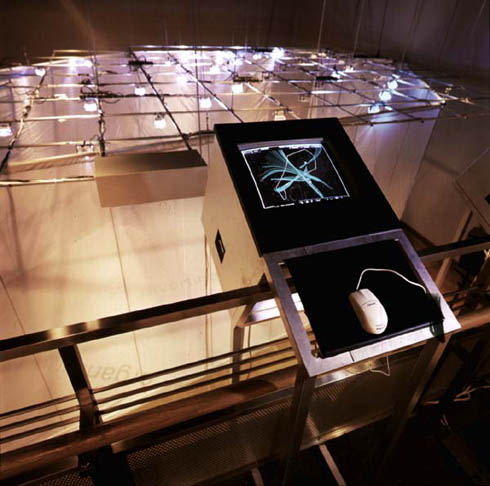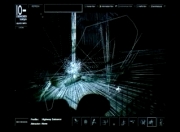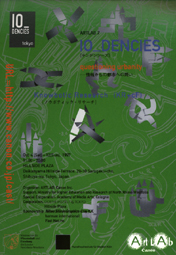
The exhibition site was constructed as an energetic metallic field of image projections, sounds and strobe lights, which by reacting to events of the IO_DENCIES in the network continuosly changed their intensities.
The exhibition was divided into three parts. On the upper floor, there were computer terminals and projections of the applet which allowed an active participation by visitors in the project. Via a flight of stairs, visitors could reach the lower floor where metallic gauze curtains outlined the shape of the Shimbashi area. The third part, the area between upper and lower floor, was made up by a grid of small strobe-lights through which visitors on the upper floor could look into the lower space.
The strobe-lights were activated by all active flowing movement attractors in the system - the concentration of light events and the swaying of stroboscopic waves across the grid related to the activities and machinic events in the network environment. Each attractor had been allocated a certain sound synthesis which was activated and modulated through the activity in an urban profile. If a certain user engaged strongely in the processes of the Net, the sounds generated by his activities changed the intensity and scale of the exhibition space with dynamic changing layers of ambient noise. Visitors who had chosen to go into the lower part of the metallic gauze, into the >built space<, put themselves in a receptive position where they could experience but not participate in the processes that determine the modes of their experience. They were given small,hand-held devices which display Quicktime movies that are visual and textual notations of the architect who was reading the urban profiles of the Shimbashi area. The movement and concentration relations of visitors in parts of the lower exhibition space influenced via sensors the choice of Quicktime movies that are transmitted to the hand-held devices, and the same data about physical concentrations in the exhibition space were also used to influence the probability with which users on the Internet would be allocated certain profiles in the Java applet. Sometimes, when there was little or no activity on the net, the lower gallery space had fallen completely dark and was turned into an empty black informational hole. It was possible to look into the lower space from the upper gallery, both through the grid of strobes and through the semi-transparent gauze walls. In the opposite direction, from inside the lower gallery space, it was not possible to look outside and up through the 'membrane' of reflecting, non-transparent metallic gauze and the field of strobe-lights. Presence on the net and the ability to act is here opposed to physical visibility and passivity. The networked activity created visibility of the passive physcial visitors, and the presence of the active net-participants.
exhibition situation
1997

UP= Hinode Ship Terminal
